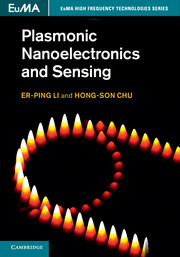Book contents
- Frontmatter
- Contents
- List of contributors
- Preface
- 1 Fundamentals of plasmonics
- 2 Plasmonic properties of metal nanostructures
- 3 Frequency-domain methods for modeling plasmonics
- 4 Time-domain simulation for plasmonic devices
- 5 Passive plasmonic waveguide-based devices
- 6 Silicon-based active plasmonic devices for on-chip integration
- 7 Plasmonic biosensing devices and systems
- Index
- References
2 - Plasmonic properties of metal nanostructures
Published online by Cambridge University Press: 05 March 2014
- Frontmatter
- Contents
- List of contributors
- Preface
- 1 Fundamentals of plasmonics
- 2 Plasmonic properties of metal nanostructures
- 3 Frequency-domain methods for modeling plasmonics
- 4 Time-domain simulation for plasmonic devices
- 5 Passive plasmonic waveguide-based devices
- 6 Silicon-based active plasmonic devices for on-chip integration
- 7 Plasmonic biosensing devices and systems
- Index
- References
Summary
Plasmons, being the electromagnetic eigenoscillations of intrinsic charges, play an important role in the electrodynamics of metals and determine the main optical properties of metal structures. Following the classification given in Section 1.3.1, there are two types of plasmons – longitudinal and transverse. Both types are inherent to any metal and appear equally in metal structures. Longitudinal plasmons define the optical response of metals to conservative fields, while transverse plasmons define the response to solenoidal fields. Therefore, transverse plasmons are more attractive for optical applications, since they provide resonant interaction with photons, in contrast to longitudinal plasmons, which require very specific conditions, such as certain electron density profiles or applied external magnetic/electric fields, in order for them to interact with photons. In this chapter, we consider transverse plasmons supported by different metal nanostructures in spherical, cylindrical, and planar geometries. By solving eigenvalue and scattering problems, we discuss the properties of these plasmons and study their coupling with incident photons.
Plasmonic modes in spherical geometry
In this section, we consider the transverse eigenmodes supported in structures with spherical geometry. Within the vector spherical-harmonics formalism, we study the plasmonic modes of a metal sphere and a spherical cavity in a bulk metal. Also, we investigate the scattering of plane waves by metal nanoparticles and make a generalization for the case of a multilayer sphere.
- Type
- Chapter
- Information
- Plasmonic Nanoelectronics and Sensing , pp. 20 - 66Publisher: Cambridge University PressPrint publication year: 2014
References
- 1
- Cited by



